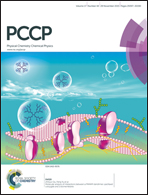Direct versus hydrogen-assisted CO dissociation over stepped Ni and Ni3Fe surfaces: a computational investigation†
Abstract
The adsorption and dissociation of CO over stepped Ni and Ni3Fe surfaces were systematically studied using density functional theory slab calculations. Both (211)-like surface structure terminations (NiNi step and NiFe step, denoted as Ni3Fe(211)-AA and Ni3Fe(211)-AB) are considered for Ni3Fe. Direct scission of the C–O bond in CO is identified as the least likely one among the three proposed dissociation pathways and CO dissociation via a CHO intermediate appears to be most feasible at low CO coverage on pure and alloyed Ni(211) surfaces. The priority of H-assisted CO dissociation might originate from the more activated C–O bond in COH and CHO. Compared to Ni(211), the Ni3Fe(211)-AB surface could facilitate CO activation especially for the most possible CHO intermediate mechanism, whose rate-limiting step is found to be altered. The d-band center theory and Mulliken charge analysis are also employed to explain the activity difference between Ni3Fe(211)-AB and Ni3Fe(211)-AA. The significant structural sensitivity of CO dissociation highlights the importance of Fe locating in the step edge and the high reactivity of Ni3Fe(211)-AB is largely ascribed to the synergistic effect between Ni and Fe at the step edge.


 Please wait while we load your content...
Please wait while we load your content...